The Netherlands is a tech-savvy nation that has scaled back the use of technology in its elections over the past decade-plus as part of its efforts to reduce the likelihood that autocratic actors, such as Russia, are able to interfere in the technical aspects of its voting process and to ensure trust in its elections. In early 2017—after voting computers had already been banned for roughly a decade—the government ordered that the counting of votes for its March 2017 parliamentary election be conducted manually as well, prohibiting the use of any technology, including computers and electronic devices like flash drives. At that point, distrust had spread to nearly anything electronic in the election process, and a good deal of that distrust was—and still is—well-founded.
Technology, however, can increase efficiency and accuracy in elections when deployed properly. For the Netherlands’s March 2021 parliamentary elections, the Dutch Electoral Council brought back election software to tally votes in parallel with the manual counting of votes, citing the software’s ability to increase accuracy. Approximately 83 percent of eligible voters cast a ballot, the highest rate of voter turnout since 1986. If the Dutch Electoral Council finds that the software worked properly during these elections, it should continue using the software for future elections and hand count a statistically significant sample of paper ballots to provide strong evidence that the reported election result was correct.
While forgoing electronic counting can reduce certain risks, it can increase others, namely the accuracy of vote-counting. A good deal of research has found that properly working technology is often better at raw counting votes than people. Machines do not tire like people do when counting lots of ballots. And hand-counting can also be boring, leading some workers to lose track or fail to read their own work correctly during the counting process.
That does not mean Dutch workers should have no role in the counting of votes. To the contrary, they must continue to have a critical one, but it should generally be to check the accuracy of the election counting software, not to count every single ballot.
One way the Dutch election officials could do this while maintaining public confidence in their elections is to perform a post-election risk limiting audit (RLA) of its ballots. RLAs involve manually examining random samples of paper ballots. When the sample provides sufficient evidence that the reported outcome is correct, the audit stops; otherwise, it progresses to a full manual tally to ensure results are correct. An RLA can cut down on the number of ballots that need to be manually counted in any given election, while also providing statistical confidence that an incorrect election result is not made official, reducing both the time and money it takes to certify an election and serving as an important bulwark against interference from both foreign and domestic actors.
Reducing the time it takes to certify the election can also make it more difficult for malign actors to undermine confidence in the election results. Efforts to interfere in the certification of the parliamentary elections thus far have not been significant. But as we have seen in other countries’ elections, malign actors can exploit the time required to certify and announce election results by disseminating disinformation that can include reports of voter suppression, cyberattacks targeting election infrastructure, election fraud, and other problems intended to the convince the public of the elections’ illegitimacy. Using counting technology to quickly provide the public with unofficial results, followed by a manual audit to ensure the reported outcomes are correct could go a long way towards preventing such disinformation operations from gaining traction in future elections.
There is no mechanism to fully secure tabulation computer systems from cyber threats, but those working on the front lines of elections can adopt methods that assure the accuracy of the election without relying on any hardware or software used to conduct the election. A risk-limiting audit does not prevent tampering with results tabulated by election counting software, but it allows such tampering to be detected, thereby ensuring that an election accurately reflects the will of the electorate without a need to trust the equipment used to conduct the election.
Machines are better than people at counting large volumes of ballots so as long any technology that is used is not a single point of failure.
The views expressed in GMF publications and commentary are the views of the author alone.





